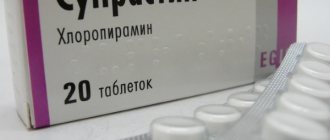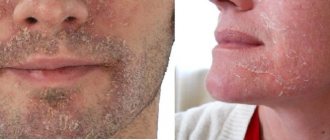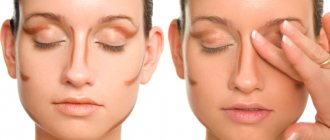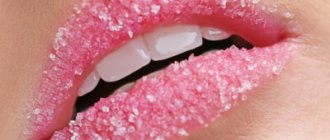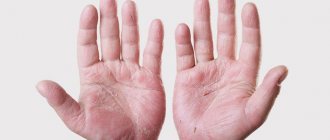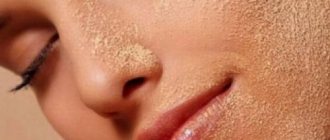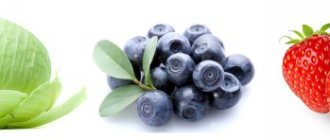Why does the skin peel around the nose?
When old cells die and do not have time to exfoliate naturally, light scales appear on the skin, giving a person a sickly appearance. The main cause of dryness is considered to be a violation of the water-fat balance. The pathological process is facilitated by:
- chapping of the face;
- exposure to ultraviolet radiation;
- unsuitable cosmetic care products;
- avitaminosis;
- temperature difference;
- chronic fatigue and stress.
Around the nose there are large sebaceous glands that influence the formation of blackheads and pimples. The inflammatory process causes the skin to become red and flaky.
Respiratory diseases cause a negative reaction. Instillation of medicinal drops into the nose and discharge of mucus provoke redness and itching. The person constantly wipes his nose with a handkerchief, increasing irritation. As healing progresses, the affected areas become covered with scales, which gradually disappear.
If irritation and peeling on the nose continues for a long time, do not ignore the problem, but get examined to exclude the development of dangerous diseases. Symptoms may be heralds:
- allergic reaction. The disease manifests itself chronically with a runny nose and lacrimation. There are inflamed areas around the nose that are very itchy;
- seborrheic dermatitis. The pathology is provoked by a fungus that causes excessive oiliness, pimples and red flaky spots on the nose;
- demodicosis. A microscopic mite attacks the sebaceous glands. Swelling and inflamed purple areas form on the face;
- diabetes mellitus The disease disrupts the functioning of internal organs and systems. The imbalance is manifested by itchy skin and flaking on the nose, hands and other parts of the body;
- psoriasis. An autoimmune disease affects healthy epidermal cells. A scaly layer appears on the skin. Psoriatic plaques are located not only around the nose, but also in the scalp, behind the ears, and under the armpits.
Important! The primary task to guarantee successful treatment is to find out why the skin on your face is peeling. Having gotten ahead of the provoking factor, eliminate its harmful influence. If this is not done, you will not be able to completely get rid of the redness.
Redness and peeling on the wings of the nose
The anxiety that reddened and flaky wings of the nose cause is comparable only to a natural disaster. Indeed, one has to forget about the beauty of appearance, since no amount of makeup can hide the flaking scales and untidy redness around the nose. But inflammation on the wings of the nose also causes unpleasant itching, at times intensifies and does not want to disappear. Why does this disaster appear on the face? And what to do if the wings of the nose turn red and peel?
Why do the wings of the nose peel?
The causes of redness and flaking of the nose can be quite simple and distinct. Let's say your runny nose worsened or inflammation of the nasal mucosa occurred, and the wings of your nose turned red from getting wet and rubbing with a handkerchief. Peeling of the nose can occur due to the wrong soap, which dries out the skin when washing. The wings of the nose often turn red and peel when exposed to strong damp winds, in frosty weather or during abnormal heat.
If the skin around your nose is red and flaky, there could be a lot of reasons for this. 60226
In all of these cases, to treat flaky skin around the nose, regular use of nourishing and moisturizing face creams, taking immune-strengthening drugs and, of course, eliminating the source of skin irritation is quite sufficient.
The cause of redness and peeling of the skin on the wings of the nose can be vitamin deficiency, as well as an allergic reaction to any irritant. That is why, if irritation around the nose does not go away for a long time, seek help from a dermatologist. The doctor will help determine the cause of the allergy and select a multivitamin complex to get rid of annoying flaking of the skin. Don't let the intermittent redness and flaking of the skin around your nose take its course, because untreated allergies can become chronic.
However, there are also more complex types of inflammation, when the cause of redness and peeling of the skin on the wings of the nose can only be determined by an experienced dermatologist, and treatment will take a lot of effort and time.
One of the causes of redness and flaking around the nose may be demodicosis. This disease is caused by the skin tick-borne parasite demodex, which, in fact, is present under the skin in 97% of citizens, but is not activated in everyone. Demodicosis can occur against the background of hormonal shock during pregnancy or puberty, against the background of severe stress or after a serious illness, i.e. when the body's defenses are greatly depleted.
Diagnosing demodicosis is not easy, since the mite can go into the deeper layers of the skin and not appear during the collection of tests. Treatment for this disease can take a very long time, often at least a year. It includes taking antibacterial agents, restoring the protective properties of the skin, strengthening the immune system, and normalizing metabolic disorders. And only a few months after the start of treatment, you will breathe a sigh of relief about the disappearance of itchy red spots on the wings of the nose and the smoothing of flaky skin.
Problems with the skin around the nose can be caused by the fungus Pityrosporum ovale, which causes facial seborrhea, manifested by redness and peeling of the skin of the wings of the nose. The reasons for the activation of the fungus lie, as usual, in the weakening of the immune system, when the body’s defenses are undermined by exacerbation of chronic diseases, nervous overstrain, disorders of the gastrointestinal tract, and hormonal disorders. Seborrheic dermatitis on the face is often combined with inflammation of the skin in the eyebrows and scalp.
To clarify the diagnosis, the dermatologist prescribes skin dermatoscopy, blood tests and hormonal studies. Treatment will be long-term, including a hypoallergenic diet, a complex of vitamins and minerals, especially selenium and zinc, antifungal and antibacterial drugs, and if the disease develops into eczema, hormonal ointments may be needed.
To speed up the healing of facial skin and get rid of flaking, cryomassage and exposure to high-frequency currents are used. These cosmetic procedures soothe inflamed skin, improve blood microcirculation, dry out flaking on the wings of the nose, strengthening the epidermis.
How to relieve nasal peeling?
During treatment prescribed by a dermatologist, try not to scrape off the dried scales so as not to damage the sensitive epidermis. When cleaning the affected area of skin, moisten it with a damp swab, remove the soaked scales, and then lubricate the skin with a fat-based moisturizer.
Try to follow a hypoallergenic diet: exclude chocolate, hot and salty seasonings from your diet. Do not expose your face to direct sunlight, which can increase inflammation.
How to mask redness and flaking of the nose?
Inflamed and flaky skin on the wings of the nose is unlikely to look attractive under a thick layer of foundation and powder. On the one hand, pimples deprived of air will become even more inflamed, and on the other hand, loose powder will absorb the released excess sebum and curl into untidy flakes, adding trouble along with flaky skin.
Use a green or yellow-beige color corrector, it will neutralize the redness of the skin around the nose. Apply the corrector directly to the inflamed area and carefully blend the boundaries of the applied corrective agent. To disguise individual pimples, a tinting pencil with antiseptic properties is suitable.
However, do not get carried away with masking the inflamed skin around the nose, but try, without delay, to consult a dermatologist about the causes of redness and peeling of the skin on the wings of the nose, so as not to miss the development of a serious disease.
What to do to prevent skin from peeling
Peeling can be eliminated with comprehensive preventive measures. Be sure to review your diet and include dishes rich in B vitamins, tocopherol and retinol. Eat more:
- fresh carrots;
- green vegetables;
- sea fish;
- dairy products;
- nuts;
- whole grain porridge.
Advice. Avoid eating citrus fruits, chocolate, smoked meats and pickles. They are a common cause of allergic reactions that appear on the nose.
Drink at least 2 liters of clean water daily to prevent lack of moisture in your cells. During the off-season, take vitamin complexes to increase the body's defenses.
A red, scaly nose does not tolerate hot or ice water. To wash your face, use mineral water at room temperature. Avoid alkaline soap. Cleanse with cosmetic milk or oatmeal.
- Grind the flakes with a coffee grinder and place in a plastic container.
- Before washing, pour a little powder into your palm and dilute with warm water until it becomes sour cream. Apply to face, massage the sides of the nose and rinse.
- Do not rub your skin with a towel. Gently blot the moisture with a napkin, wipe the dermis with tonic and apply moisturizer.
Do not use alcohol-based products for daily care. They dry out and increase flaking. When going outside in the summer, protect your face from ultraviolet radiation with special means. In winter, use a thick foundation that protects from frost and wind.
If the area around your nose is covered with white scales, under which red spots have formed, do not rush to clean them with your fingers. First, soak the peeling with water and lubricate with Vaseline. Take a piece of gauze, folded several times, and rub the affected areas, removing the scales. After completing the manipulation, rinse the epidermis with chamomile infusion, dry and lubricate with cream.
What warns you about the onset of peeling?
You can tell that the skin on your nose is peeling by the following symptoms:
- the appearance of redness on and around the nose;
- burning and itching;
- feeling of tightness and dryness of the skin;
- the appearance of swelling and pain in the irritated area.
This problem can occur in women, men and even children. Thus, peeling on, under and around the nose affects many people.
The skin can peel off due to changes in season and weather, place of residence, cosmetics, and diet. However, it can also be due to a very serious illness. Therefore, it is very important to establish why the problem occurred. It is necessary to understand the main factors that affect peeling and redness of the skin.
So, why does your nose peel?
Dermatologists identify several reasons that cause such an unpleasant symptom: allergic reactions; avitaminosis; runny nose; failure to comply with hygiene standards; external factors; various kinds of pathologies.
Recommendations from cosmetologists
Experts advise getting tested and, if peeling is a consequence of pathological processes in the body, undergoing appropriate therapy. To exclude a fungal infection, a scraping is taken from the reddened area. The doctor examines the scales and determines the presence of pathogenic flora.
Cosmetologists recommend a combination treatment, including:
- proper nutrition;
- salon treatments;
- medicinal ointments and creams;
- traditional methods.
Flaky skin near the nose ceases to bother you after a course of moisturizing professional masks. The doctor selects ingredients that match the type of epidermis. Good results are provided by collagen, hyaluronic acid, emollient oils, herbs, and seaweed.
Mesotherapy eliminates red spots and peeling on the nose. The procedure involves the injection of various drugs under the skin. To treat acne and relieve inflammation, absorbent and antibacterial agents are used, and moisturizing components are used to soften.
This is interesting! Biorevitalization helps against severe dehydration. During the session, hyaluronic acid is injected into the deep layers of the skin. The procedure triggers cell regeneration, restores metabolic processes, and eliminates dryness and sagging.
When the wings of the nose peel off, cosmetologists offer salon peeling, hardware massage, and paraffin therapy. One of these procedures is shown in the video:
Features of treatment in different people
There are no obvious features in the treatment of skin peeling in men, women and children. It is only necessary to select suitable products taking into account gender and age.
Peeling on the nose can occur in men due to a problem such as dandruff, which is initially localized on the eyebrows. White scales sometimes form not in the eyebrow arches themselves, but above the forehead, temples and in the nose area. To treat this condition you can use:
- antifungal agents (creams with ketoconazole);
- antiseborrheic drugs (sulsen paste);
- dermatological creams (A-Derma Dermalibour);
- glucocorticosteroids and corticosteroids (Celeston, Kenalog, Hydrocortisone-Richter).
In women, peeling occurs due to hormonal changes. In such cases, it is necessary to take hormonal drugs selected by a doctor. Peeling skin is a common occurrence during pregnancy. During these periods, the body becomes more susceptible to various types of influences. To get rid of a skin defect, a pregnant woman should make vitamin masks (mix 3 drops of liquid vitamins A and E with 2 tablespoons of oatmeal and a drop of olive oil).
To treat peeling on the nose in women from vitamin deficiency, taking vitamins designed specifically taking into account physiological characteristics is recommended. For example:
- Famvital;
- Imedin;
- ArtLife. Woman's Formula;
- Evalar Laura;
- Lady's formula.
The skin near the nose can also peel in a child. Most often this occurs due to skin sensitivity or vitamin deficiency (in a baby there is a lack of vitamins C, A and E). To eliminate the symptom, drugs can be used whose contraindications do not include children's age. These include:
- Bepanten (from birth);
- calendula ointment (at any age);
- Solcoseryl ointment (from one year);
- Levomekol ointment (from birth).
The best remedies for flaking around the nose
It is easier to achieve the best results by combining the use of pharmaceutical drugs and traditional methods. If the skin on your nose is peeling, carry out the procedures regularly and coordinate the actions with a cosmetologist. This will help prevent adverse reactions and worsening of the condition.
Pharmacy drugs
Pharmacies sell ointments and creams that eliminate the inflammatory process and remove peeling.
- Bepanten provides quick results. The ointment contains dexpanthenol, which, penetrating deep into the skin, is converted into vitamin B5. The substance activates metabolic processes, heals damage and rashes. Bepanten is applied to the cleansed dermis 1-2 times a day and rubbed in thoroughly.
- Pantoderm ointment is useful, which forms a protective film that protects from the harmful influences of the environment and accelerates healing. The ointment quickly soothes itching and removes peeling of the skin.
- It is useful to lubricate rough areas around the nose with baby cream with the addition of vitamins A and E, cosmetic Vaseline, including mink oil, and warm sea buckthorn oil.
If the skin around your nose is peeling due to allergies or a fungal infection, powerful medications are needed. Hydrocortisone ointment is highly effective. The product is distributed in a thin layer onto the areas of redness 1-2 times a day. The course of therapy is no longer than 2 weeks. You can buy Griseofulvin ointment, Mycocid lotion, Dermazol.
For seborrheic dermatitis the following are in demand:
- Nystatin ointment;
- Ketoconazole;
- zinc paste;
- Sulfuric ointment.
Redness caused by a runny nose is eliminated with oxolinic ointment or Viferon.
A persistent infection that causes redness between the sinuses is treated with antibiotics. Effective ointments: Gentamicin, Tetracycline, Erythromycin.
Attention! Use hormonal external agents and antibiotics only as prescribed by a doctor. They are fast-acting, but have many contraindications, so self-medication is unacceptable.
Traditional methods
Using unconventional methods, you can solve the problem caused by excessive dryness, chapping, and inappropriate cosmetic care. In other cases, traditional medicine recipes are used as auxiliaries that complement the main treatment.
Masks
Mix a spoonful of natural honey with mineral water in equal proportions. Apply to inflamed areas with a cotton pad, massage with your fingers, leave for 5 minutes and wash.
- A simple mask quickly copes with flaky skin on the nose. Pour a spoonful of oatmeal with a small amount of boiling milk. After 10 minutes, strain off excess liquid. Add a teaspoon of olive oil and May honey to the warm porridge. Apply the mixture to your nose. After 20 minutes, wash off the composition.
- Mash a large spoonful of homemade cottage cheese with a fork, after adding a spoonful of olive oil. Wash the parsley sprigs and chop. Take a spoon and mix with cottage cheese. Distribute over problem areas and do not rinse for 20 minutes.
- Pour a tablespoon of linden blossom into a glass of boiling water. After half an hour, filter. Place a spoonful of oatmeal and olive oil in a ceramic bowl and pour in the linden infusion a little at a time, stirring constantly. The composition should acquire the consistency of liquid sour cream. Lubricate the epidermis around the nose and face along the massage lines. After 15 minutes, clean the skin with a cotton pad soaked in linden infusion.
And this simple and affordable remedy will allow you to get rid of peeling after 2-3 applications:
Apply anti-flaking masks daily for a week. If the problem does not disappear during this time, consult a cosmetologist.
Treatment methods
If the skin condition does not improve, and the skin peels more, then you should consult a dermatologist. By self-medicating, you can significantly worsen the situation. You should immediately visit a doctor if you have the following symptoms:
- the appearance of eczema;
- occurrence of cracks;
- the appearance of pain;
- increase in the area of peeling.
Therapy for each condition is carried out in accordance with the disease. As a general treatment, your doctor may prescribe:
- creams;
- vitamin complexes;
- drugs;
- folk remedies;
- diet.
You can get rid of peeling skin on the nose at home using folk remedies - masks. But this treatment must be agreed with a dermatologist.
Creams
If the skin begins to peel, it may have happened after using cosmetics. In this case, this indicates an allergic reaction. If this is the case, then you should stop using cosmetics for a while, and then change it to a more suitable one. The following creams are considered hypoallergenic:
- For hands: Mineral Hand Cream, Ahava.
- For eyelids: Pep-Start, Clinique.
- For the face: Toleriane Riche, La-Roche-Posay.
If the skin peels off after a long stay in the sun or in the cold, then before going outside you should use special protective creams:
- From the sun: Hydrance Optimale Creme hydratante UV Legere SPF 20, Avene.
- From wind, cold: Hirudo Derm Sensi Protect Extreme.
If the causes of peeling are caused by mechanical stress (frequent use of paper towels), then a moisturizer (Galderma Cetaphil DERMA CONTROL) will help.
Vitamin complexes
It is necessary to replenish vitamins comprehensively. The most beneficial for facial skin are the following:
- calciferol (D) - reduces the symptoms of psoriasis (flaking and redness);
- ascorbic acid (C) - promotes collagen production;
- retinol (A) - has moisturizing and rejuvenating effects;
- nicotinic acid (PP) - cleanses facial pores, activates vascular blood flow;
- tocopherol (E) - makes the epidermis smooth;
- phylloquinone (K) - stimulates the skin restoration process;
- group B - prevent peeling, eliminate the appearance of dermatitis.
For this purpose, vitamin complexes are used. The list of the most effective includes the following names:
- Vitrum;
- Calcium-D3 Nycomed;
- Calcium-Active;
- Calcide;
- Vitalipid;
- Doppelhertz Active.
Drugs
To get rid of peeling, in addition to creams, healing ointments are applied to the skin. They must be used in accordance with the instructions for each drug.
Names of pharmaceutical ointments that help cope with peeling:
- Hydrocortisone 5%;
- Aquaphor;
- Dexpanthenol;
- Bepanten;
- Panthenol;
- Zinc ointment;
- La Cree;
- Losterol;
- Lipobase.
Folk remedies
You can cope with areas of peeling and soothe inflamed skin at home using masks. Before using them, it is necessary to test for an allergic reaction. It is forbidden to use folk remedies if there is an individual sensitivity to their ingredients.
Recipes for preparing and using masks for peeling skin:
| Mask name | Ingredients | Cooking method | How to use |
| Egg mask |
| Mix the yolk with juice |
|
| Fruit mask |
| Mix the ingredients until it becomes creamy | Apply to face for 15 minutes |
| Colloidal oatmeal mask |
|
|
|
| Sour cream mask |
| Mix the components in equal proportions |
|
| Peppermint mask |
|
|
|
You can remove dead epidermal cells from the skin using a compress. Gauze needs to be moistened in chamomile infusion (1 tablespoon of raw material per glass of boiling water) and placed on the nose for a few minutes.
Diet
You can improve the condition of your skin, eliminate and subsequently prevent peeling by following a diet. There are a number of products, the use of which leads to a decrease in the skin’s resistance to various weather conditions and adverse factors. All this causes accelerated rejection of epidermal cells.
To normalize nutrition you need:
- eat a lot of fruits and vegetables;
- exclude strong tea, spicy and fatty foods, fast food;
- try not to eat sweets and starchy foods;
- give preference to herbal and berry drinks.
Redness
Red spots or completely red wings of the nose cannot be hidden under any makeup. And this is a huge problem. Most often, redness is accompanied by peeling, and the nose may even itch. A possible cause could be a worsening runny nose.
Redness can also be caused by incorrectly selected soap or cosmetics. Redness can also be observed outdoors, in strong winds or frost, or, conversely, in extreme heat. But such symptoms, as a rule, disappear 40 minutes after coming from the cold to a warm room.
But there are other reasons. If there is no runny nose and the redness of the wings of the nose does not go away, then perhaps the person has an acute allergy, which is usually accompanied by other symptoms.
Redness can also occur due to vitamin deficiency. In these cases, it is necessary to use vitamin complexes, but only those prescribed by a doctor.
